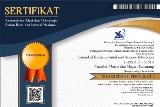Geospatial Assessment of Aridity and Erosivity Indices in Northwest Somalia Using The CORINE Model
DOI:
https://doi.org/10.15294/jese.v4i1.1637Keywords:
Waqooyi Galbeed, Soil, Potential erosion, Actual erosion, CORINEAbstract
The degree of soil erosion depends on the erodibility of the soil and the erosive agents. The primary energy source for soil detachment and transport in water erosion processes is rain and runoff. In the northwest region of Somalia, we thoroughly evaluated the aridity and erosivity indices. This study, aridity and erosivity indices and arid periods of Woqoyi Galbeed were assessed. In the CORINE methodology, four parameters are used to evaluate the potential and actual soil erosion risks: Soil erodibility, erosivity, topography (slope), and land cover. Fournier Precipitation Index and Bagnouls-Gaussen Drought Index were calculated using rainfall data that were measured from 2011–2019 in the region and temperature data that were taken from 50 meteorological stations. The study illustrates that most of the study area is under moderate erosion risk. Although a small portion of the Southern parts of the study areas have high erosion risk, these areas have low erosion risk due to the very steep slope. The Erosivity Index quantifies the effect of rainfall impact and also reflects the amount and rate of runoff likely to be associated with precipitation events. Evaluating the result of MFI and BGI overlaid shows that there is low erosivity risk in the northern part of the country. It includes the Bossaso, Aburin, Dararweyne, Burco, Xudun and Iskushuban weather stations. It is covering the area of 204978, 65km2, which represents 32.14% of the study area. This indicates that Northern part of the country, annual rainfall is low, whereas some areas like Erigabo and gebiley are relatively moderate in the MFI.
